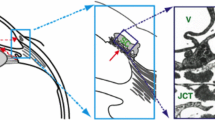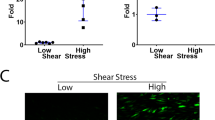Abstract
Schlemm’s canal (SC) endothelial cells are likely important in the physiology and pathophysiology of the aqueous drainage system of the eye, particularly in glaucoma. The mechanical stiffness of these cells determines, in part, the extent to which they can support a pressure gradient and thus can be used to place limits on the flow resistance that this layer can generate in the eye. However, little is known about the biomechanical properties of SC endothelial cells. Our goal in this study was to estimate the effective Young’s modulus of elasticity of normal SC cells. To do so, we combined magnetic pulling cytometry of isolated cultured human SC cells with finite element modeling of the mechanical response of the cell to traction forces applied by adherent beads. Preliminary work showed that the immersion angles of beads attached to the SC cells had a major influence on bead response; therefore, we also measured bead immersion angle by confocal microscopy, using an empirical technique to correct for axial distortion of the confocal images. Our results showed that the upper bound for the effective Young’s modulus of elasticity of the cultured SC cells examined in this study, in central, non-nuclear regions, ranged between 1,007 and 3,053 Pa, which is similar to, although somewhat larger than values that have been measured for other endothelial cell types. We compared these values to estimates of the modulus of primate SC cells in vivo, based on images of these cells under pressure loading, and found good agreement at low intraocular pressure (8–15 mm Hg). However, increasing intraocular pressure (22–30 mm Hg) appeared to cause a significant increase in the modulus of these cells. These moduli can be used to estimate the extent to which SC cells deform in response to the pressure drop across the inner wall endothelium and thereby estimate the extent to which they can generate outflow resistance.
Similar content being viewed by others
References
Allingham RR, de Kater AW, Ethier CR, Anderson PJ, Hertzmark E, Epstein DL (1992) The relationship between pore density and outflow facility in human eyes. Invest Ophthalmol Vis Sci 33(5): 1661–1669
Alvarado JA, Alvarado RG, Yeh RF, Franse-Carman L, Marcellino GR, Brownstein MJ (2005) A new insight into the cellular regulation of aqueous outflow:how trabecular meshwork endothelial cells drive a mechanism that regulates the permeability of Schlemm’s canal endothelial cells. Br J Ophthalmol 89(11): 1500–1505. doi:10.1136/bjo.2005.081307
Bausch AR, Ziemann F, Boulbitch AA, Jacobson K, Sackmann E (1998) Local measurements of viscoelastic parameters of adherent cell surfaces by magnetic bead microrheometry. Biophys J 75(4): 2038–2049. doi:10.1016/S0006-3495(98)77646-5
Bill A, Svedbergh B (1972) Scanning electron microscopic studies of the trabecular meshwork and the canal of Schlemm—an attempt to localize the main resistance to outflow of aqueous humor in man. Acta Ophthalmol (Copenh) 50: 295–320
Braet F, Rotsch C, Wisse E, Radmacher M (1998) Comparison of fixed and living liver endothelial cells by atomic force microscopy. Appl Phys A Mater Sci Process 66: S575–S578
Burke A, Roberts B, O’Brien E, Stamer W (2002) Effects of Na2EDTA and hydrostatic pressure on transendothelial electrical resistances and hydraulic conductivity of human Schlemm’s canal monolayers (in review)
Caille N, Thoumine O, Tardy Y, Meister JJ (2002) Contribution of the nucleus to the mechanical properties of endothelial cells. J Biomech 35(2): 177–187. doi:10.1016/S0021-9290(01)00201-9
Cheezum MK, Walker WF, Guilford WH (2001) Quantitative comparison of algorithms for tracking single fluorescent particles. Biophys J 81(4): 2378–2388. doi:10.1016/S0006-3495(01)75884-5
Costa KD, Sim AJ, Yin FC (2006) Non-Hertzian approach to analyzing mechanical properties of endothelial cells probed by atomic force microscopy. J Biomech Eng 128(2): 176–184. doi:10.1115/1.2165690
Deguchi S, Maeda K, Ohashi T, Sato M (2005) Flow-induced hardening of endothelial nucleus as an intracellular stress-bearing organelle. J Biomech 38(9): 1751–1759. doi:10.1016/j.jbiomech.2005.06.003
Ethier C, Read A, Chan D (2004) Biomechanics of Schlemm’s canal endothelial cells:influence on F-actin architecture. Biophys J 87: 2828–2837. doi:10.1529/biophysj.103.038133
Ethier CR (2002) The inner wall of Schlemm’s canal (REVIEW). Exp Eye Res 74: 161–172. doi:10.1006/exer.2002.1144
Ethier CR, Simmons CA (2007) Introductory biomechanics: from cells to organisms. Cambridge University Press, Cambridge
Ethier CR, Zeng D, Read AT, Chan D, Gong H, Johnson M (2008) Pressure-induced deformation of Schlemm’s canal endothelial cells. ARVO, Ft. Lauderdale
Feneberg W, Aepfelbacher M, Sackmann E (2004) Microviscoelasticity of the apical cell surface of human umbilical vein endothelial cells (HUVEC) within confluent monolayers. Biophys J 87(2): 1338–1350. doi:10.1529/biophysj.103.037044
Ferko MC, Patterson BW, Butler PJ (2006) High-resolution solid modeling of biological samples imaged with 3D fluorescence microscopy. Microsc Res Tech 69(8): 648–655. doi:10.1002/jemt.20332
Fung Y (1977) A first course in continuum mechanics. Prentice-Hall Inc., Englewood Cliffs
Gelles J, Schnapp B, Sheetz M (1988) Tracking kinesin-driven movements with nanometre-scale precision. Nature 331(4): 450–453. doi:10.1038/331450a0
Gilmont R (2002) Measurement and control liquid—viscosity correlations for flowmeter catculations. Chem Eng Prog 98(10): 36–41
Grierson I, Lee WR (1975) Pressure-induced changes in the ultrastructure of the endothelium lining Schlemm’s canal. Am J Ophthalmol 80: 863–884
Grierson I, Lee WR (1977) Light microscopic quantitaion of the endothelial vacuoles in Schlemm’s canal. Am J Ophthalmol 84: 234–246
Henon S, Lenormand G, Richert A, Gallet F (1999) A new determination of the shear modulus of the human erythrocyte membrane using optical tweezers. Biophys J 76(2): 1145–1151. doi:10.1016/S0006-3495(99)77279-6
Hogan MJ, Alvarado JA, Weddel J (1971) Histology of the human eye: an atlas and textbook. W.B. Saunders Co., Philadelphia
Humphrey J (2002) On mechanical modeling of dynamic changes in the structure and properties of adherent cells. Math Mech Solids 7: 521–539. doi:10.1177/108128650200700504
Johnson M (2006) What controls aqueous humour outflow resistance?. Exp Eye Res 82(4): 545–557. doi:10.1016/j.exer.2005.10.011
Johnson M, Chan D, Read T, Christensen C, Sit A, Ethier CR (2002) The pore density in the inner wall endothelium of Schlemm’s canal of glaucomatous eyes. Invest Ophthalmol Vis Sci 43: 2950–2955
Karcher H, Lammerding J, Huang H, Lee RT, Kamm RD, Kaazempur-Mofrad MR (2003) A three-dimensional viscoelastic model for cell deformation with experimental verification. Biophys J 85(5): 3336–3349. doi:10.1016/S0006-3495(03)74753-5
Karl MO, Fleischhauer JC, Stamer WD, Peterson-Yantorno K, Mitchell CH, Stone RA, Civan MM (2005) Differential P1-purinergic modulation of human Schlemm’s canal inner-wall cells. Am J Physiol Cell Physiol 288(4): C784–C794. doi:10.1152/ajpcell.00333.2004
Kass MA, Heuer DK, Higginbotham EJ, Johnson CA, Keltner JL, Miller JP, Parrish RK 2nd, Wilson MR, Gordon MO (2002) The Ocular Hypertension Treatment Study: a randomized trial determines that topical ocular hypotensive medication delays or prevents the onset of primary open-angle glaucoma. Arch Ophthalmol 120(6): 701–713. see comment. discussion 829–30
Kataoka N, Iwaki K, Hashimoto K, Mochizuki S, Ogasawara Y, Sato M, Tsujioka K, Kajiya F (2002) Measurements of endothelial cell-to-cell and cell-to-substrate gaps and micromechanical properties of endothelial cells during monocyte adhesion. Proc Natl Acad Sci USA 99(24): 15638–15643. doi:10.1073/pnas.242590799
Laurent VM, Henon S, Planus E, Fodil R, Balland M, Isabey D, Gallet F (2002) Assessment of mechanical properties of adherent living cells by bead micromanipulation: comparison of magnetic twisting cytometry vs optical tweezers. J Biomech Eng 124(4): 408–421. doi:10.1115/1.1485285
Maepea O, Bill A (1992) Pressures in the juxtacanalicular tissue and Schlemm’s canal in monkeys. Exp Eye Res 54(6): 879–883. doi:10.1016/0014-4835(92)90151-H
Mathur AB, Collinsworth AM, Reichert WM, Kraus WE, Truskey GA (2001) Endothelial, cardiac muscle and skeletal muscle exhibit different viscous and elastic properties as determined by atomic force microscopy. J Biomech 34(12): 1545–1553. doi:10.1016/S0021-9290(01)00149-X
Mathur AB, Reichert WM, Truskey GA (2007) Flow and high affinity binding affect the elastic modulus of the nucleus, cell body and the stress fibers of endothelial cells. Ann Biomed Eng 35(7): 1120–1130. doi:10.1007/s10439-007-9288-8
Matthews BD, Overby DR, Alenghat FJ, Karavitis J, Numaguchi Y, Allen PG, Ingber DE (2004) Mechanical properties of individual focal adhesions probed with a magnetic microneedle. Biochem Biophys Res Commun 313(3): 758–764. doi:10.1016/j.bbrc.2003.12.005
Mijailovich SM, Kojic M, Zivkovic M, Fabry B, Fredberg JJ (2002) a finite element model of cell deformation during magnetic bead twisting. J Appl Physiol 93(4): 1429–1436
Miyazaki H, Hayashi K (1999) Atomic force microscopic measurement of the mechanical properties of intact endothelial cells in fresh arteries. Med Biol Eng Comput 37(4): 530–536. doi:10.1007/BF02513342
Oden JT (1967) Mechanics of elastic structures. McGraw-Hill, New York
Ohayon J, Tracqui P (2005) Computation of adherent cell elasticity for critical cell-bead geometry in magnetic twisting experiments. Ann Biomed Eng 33(2): 131–141. doi:10.1007/s10439-005-8972-9
Ohayon J, Tracqui P, Fodil R, Fereol S, Laurent VM, Planus E, Isabey D (2004) Analysis of nonlinear responses of adherent epithelial cells probed by magnetic bead twisting: A finite element model based on a homogenization approach. J Biomech Eng 126(6): 685–698. doi:10.1115/1.1824136
Overby DR, Matthews BD, Alsberg E, Ingber DE (2005) Novel dynamic rheological behavior of individual focal adhesions measured within single cells using electromagnetic pulling cytometry. Acta Biomater 1(3): 295–303. doi:10.1016/j.actbio.2005.02.003
Quigley HA, Broman AT (2006) The number of people with glaucoma worldwide in 2010 and 2020. Br J Ophthalmol 90(3):262–267. see comment. doi:10.1136/bjo.2005.081224
Read AT, Chan DW, Ethier CR (2007) Actin structure in the outflow tract of normal and glaucomatous eyes. Exp Eye Res 84(1): 214–226. doi:10.1016/j.exer.2005.10.035
Sato H, Kataoka N, Kajiya F, Katano M, Takigawa T, Masuda T (2004) Kinetic study on the elastic change of vascular endothelial cells on collagen matrices by atomic force microscopy. Colloids Surf B Biointerfaces 34(2): 141–146. doi:10.1016/j.colsurfb.2003.12.013
Sato M, Nagayama K, Kataoka N, Sasaki M, Hane K (2000) Local mechanical properties measured by atomic force microscopy for cultured bovine endothelial cells exposed to shear stress. J Biomech 33(1): 127–135. doi:10.1016/S0021-9290(99)00178-5
Sato M, Theret DP, Wheeler LT, Ohshima N, Nerem RM (1990) Application of the micropipette technique to the measurement of cultured porcine aortic endothelial cell viscoelastic properties. J Biomech Eng 112(3): 263–268. doi:10.1115/1.2891183
Schrot S, Weidenfeller C, Schaffer TE, Robenek H, Galla HJ (2005) Influence of hydrocortisone on the mechanical properties of the cerebral endothelium in vitro. Biophys J 89(6): 3904–3910. doi:10.1529/biophysj.104.058750
Solon J, Levental I, Sengupta K, Georges PC, Janmey PA (2007) Fibroblast adaptation and stiffness matching to soft elastic substrates. Biophys J 93(12): 4453–4461. doi:10.1529/biophysj.106.101386
Stamer WD, Roberts BC, Howell DN, Epstein DL (1998) Isolation, culture, and characterization of endothelial cells from Schlemm’s canal. Invest Ophthalmol Vis Sci 39(10): 1804–1812
Theret DP, Levesque MJ, Sato M, Nerem RM, Wheeler LT (1988) The application of a homogeneous half-space model in the analysis of endothelial cell micropipette measurements. J Biomech Eng 110(3): 190–199
Underwood JL, Murphy CG, Chen J, Franse-Carman L, Wood I, Epstein DL, Alvarado JA (1999) Glucocorticoids regulate transendothelial fluid flow resistance and formation of intercellular junctions. Am J Physiol 277(2 Pt 1): C330–C342
Wang N, Butler JP, Ingber DE (1993) Mechanotransduction across the cell surface and through the cytoskeleton. Science 260(5111): 1124–1127. doi:10.1126/science.7684161
Wang N, Ingber DE (1995) Probing transmembrane mechanical coupling and cytomechanics using magnetic twisting cytometry. Biochem Cell Biol 73(7–8): 327–335
Yih C (1988) Fluid Mechanics: a concise introduction to the theory. West River Press, Ann Arbor
Zeng D, Juzkiw T, Ethier CR, Johnson M (2007) Estimating Young’s modulus of Schlemm’s canal endothelial cells. ARVO, Ft. Lauderdale
Author information
Authors and Affiliations
Corresponding author
Rights and permissions
About this article
Cite this article
Zeng, D., Juzkiw, T., Read, A.T. et al. Young’s modulus of elasticity of Schlemm’s canal endothelial cells. Biomech Model Mechanobiol 9, 19–33 (2010). https://doi.org/10.1007/s10237-009-0156-3
Received:
Accepted:
Published:
Issue Date:
DOI: https://doi.org/10.1007/s10237-009-0156-3




